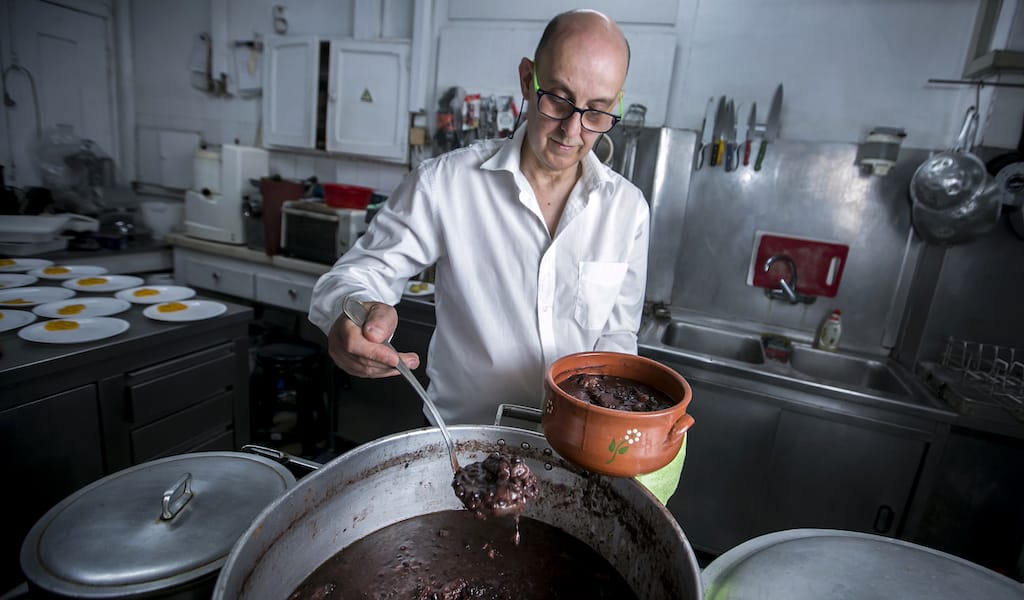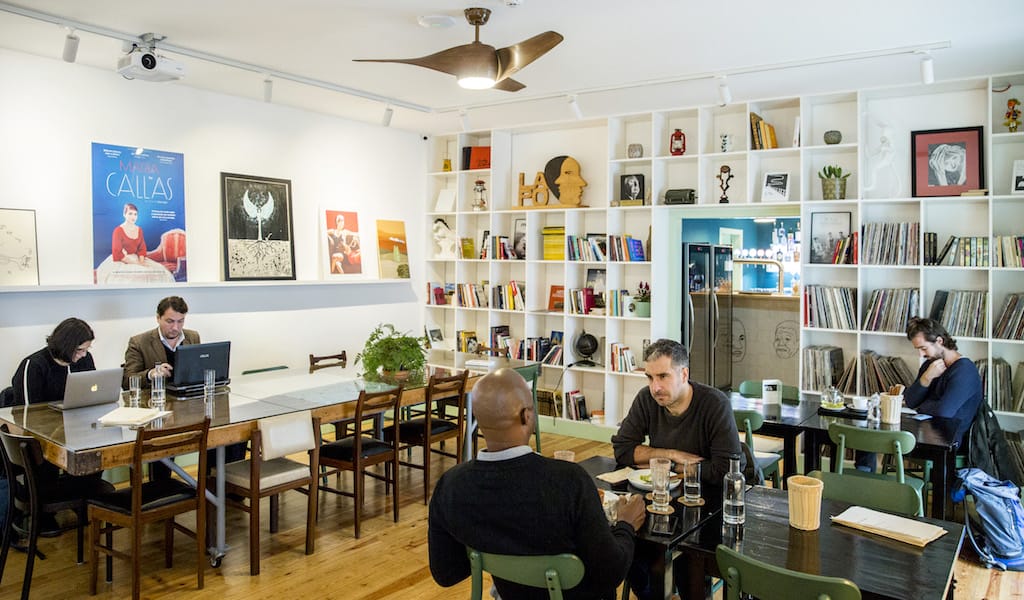Brasuca owes its existence to Mr. Oliveira da Luz, known to locals as Juca, a trade unionist who escaped from political pressures in his homeland in 1976 to settle down in the Portuguese capital. Two years later he opened this restaurant in Bairro Alto. It wasn’t the first kitchen serving Brazilian dishes in the district, as a few other tascas – particularly those with Portuguese owners who had connections to Brazil – had incorporated some Brazilian staples in their menus, particularly the feijoada, a dense meat and black bean stew, but it was the first Brazilian restaurant opened in Lisbon by a Brazilian.
The restaurant’s four rustic interior rooms, decorated with plants, wooden figures of parrots and masks, as well as vintage posters of touristic Brazilian destinations, form a kind of spatial-temporal island inside Bairro Alto.
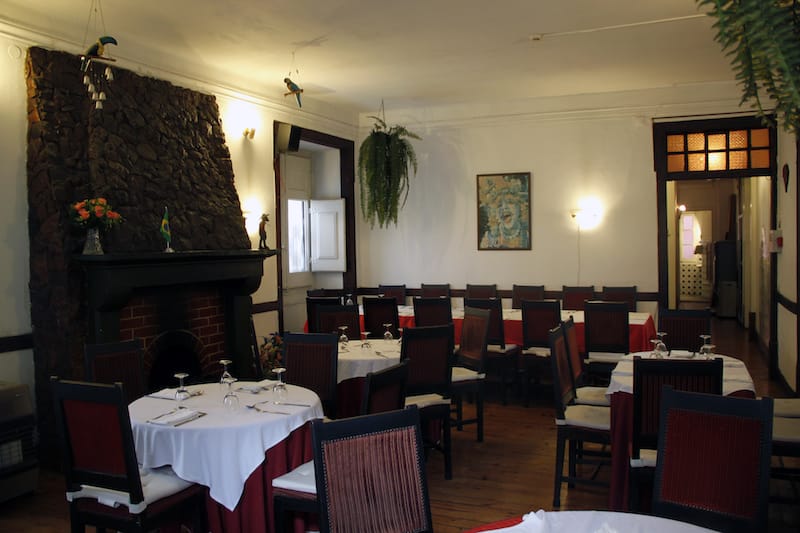
As Senhor Juca told us, the neighborhood, now a hub for bars and fashion stores, was very different when he arrived. In 1978 there were 115 restaurants huddled along the sloped 16th-century roads, and all of them were buzzing. It was the time when productive activities took place in central districts of the city; newspaper headquarters, banks and even a metallurgic factory sat among the narrow multi-family houses. In the 1980s the situation changed: worsening salaries led to less disposable income and many businesses were forced to close as a result. “Bankers suddenly were eating at the snack bar instead of my restaurant,” Juca tells us. “However, I resisted the crises of 1998 and 2008. Now I have customers from all over the world.” Tourists are behind the boost to this resilient restaurant, more often than not attracted by its retro sign on the corner of the building outside.
Born in Caxias do Sul, a city in Brazil’s southernmost state of Rio Grande do Sul, chef Juca learned to cook to feed himself and his siblings, as his parents worked long hours. He brought to Lisbon some specialties from his region, a few of which had reached his neck of the woods in the first place due to 19th-century Italian and German migration. Ch’arki is one example – given that Rio Grande do Sul was the first and largest area the gauchos were farming, this dried and salted meat made of horse, cow or llama is common to the area, and can also be found in Argentina, Uruguay and the Andean region.
At Brasuca, a special mention goes to meat dishes, in particular picanha – a cut of beef, whose thin line of fat confers incredible flavor during grilling, accompanied by white rice, fries, black beans, chopped turnip greens and the omnipresent farofa – the toasted cassava flour mixture present on all tables. Other condiments include the classic piri-piri and a sauce of raw onions, green peppers, vinegar and oil.
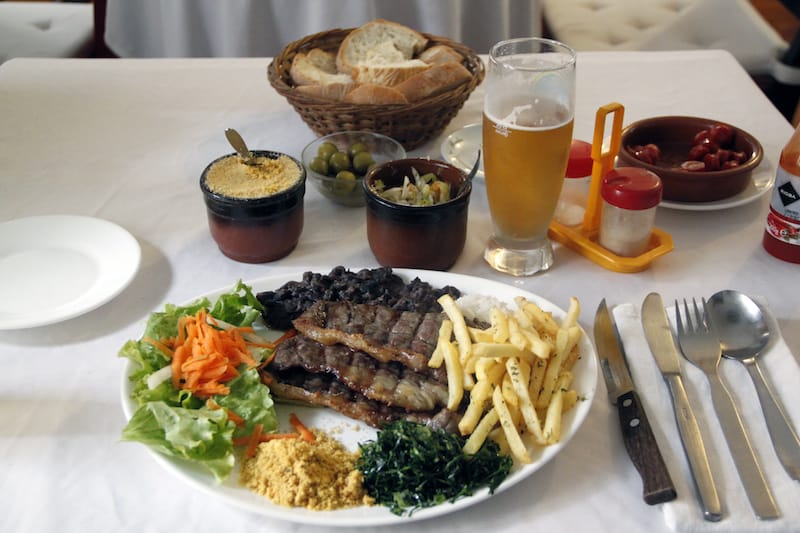
Food from other regions is also on the menu, such as the famous moqueca, a stew of salt-water fish or meat, tomatoes, onion, garlic and coriander, typical from the southeastern state of Espírito Santo and the northeastern state of Bahia. At Brasuca, the Bahia-style prawn moqueca is our favorite among the fish dishes: the prawns are cooked in palm oil, peppers and coconut milk and accompanied by pirão, a dense soupy side made of cassava flour boiled in a fish broth.
As may be expected, the feijoada, perhaps the most widely known Brazilian dish, is another star of Brasuca’s menu. Some make the claim that this dish was created by slaves in Brazil who would mix the beans with the pork leftovers (feet, ears and tail) given to them, while certain scholars argue that black beans were a staple food of the European colonizers. Whatever the origins of feijoada, the stew of beans, beef and pork (chorizo and blood sausage) was immensely popular and later introduced in other former Portuguese colonies, with variations of the dish becoming widespread in Macau, Angola, Mozambique and Goa. And it’s still eaten by all sections of Brazilian society as a celebratory tradition.
In 1970s Lisbon it was difficult to find these famous black beans, and several other ingredients necessary for a Brazilian kitchen. Senhor Juca would get them sent from Paris, where many Brazilians were living at the time, or look for them at Casa de Angola. Today, they’re easy to find, with shops popping up to serve the wave of new emigrants coming to the capital city. Brasuca, here from the beginning, will likely outlast this latest boom and stay a while longer.
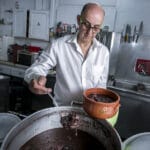 June 27, 2022 Post-Colonial Lisbon: Brazil
June 27, 2022 Post-Colonial Lisbon: Brazil
Editor’s Note: Though integral elements of Lisbon life, communities from Portugal’s […] Posted in Lisbon October 25, 2021 Galeto
October 25, 2021 Galeto
Back in 1966, when it opened on Avenida da República, one the main roads connecting the […] Posted in Lisbon December 7, 2019 Lapo
December 7, 2019 Lapo
When Lisboetas are looking for a night out on the town, Lisbon’s Bica and Bairro Alto […] Posted in Lisbon
Published on February 08, 2018
Related stories
June 27, 2022
LisbonEditor’s Note: Though integral elements of Lisbon life, communities from Portugal’s former colonies can sometimes be an invisible presence in their adopted land, pushed out to the periphery. With our "Postcolonial Lisbon” series, CB hopes to bring these communities back into the center, looking at their cuisine, history and cultural life. In this installment, we…
October 25, 2021
LisbonBack in 1966, when it opened on Avenida da República, one the main roads connecting the new avenues of Lisbon with the city center, Galeto caused quite a commotion. Lisboetas flocked to the huge snack bar, seduced by both the design – it was styled like an American diner – and the menu, which in…
December 7, 2019
LisbonWhen Lisboetas are looking for a night out on the town, Lisbon’s Bica and Bairro Alto neighborhoods aren’t as high on the list as they used to be – the area is crowded with tourist traps and expensive menus that make locals roll their eyes and run away. But António and Bruna Guerreiro saw an…













































